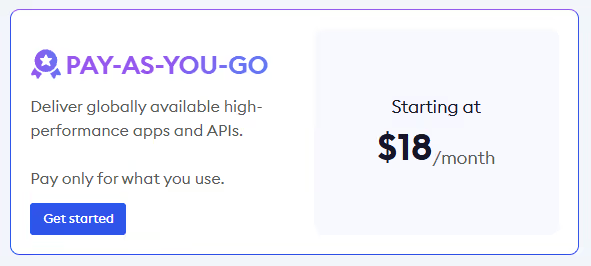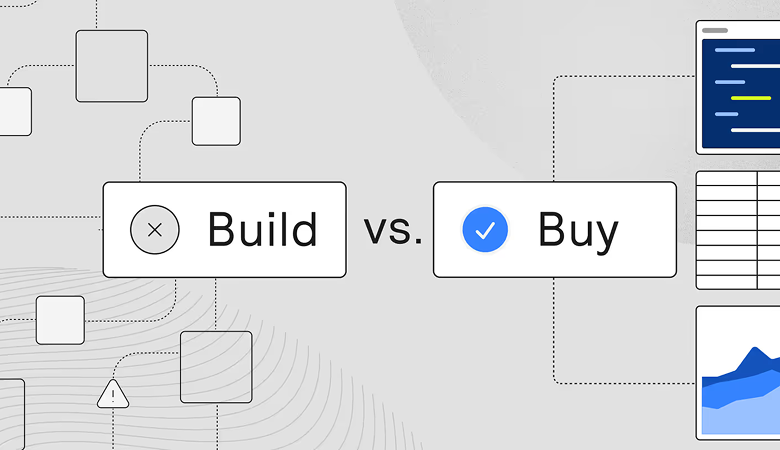ngrok allows companies to share apps or services online safely for testing, connecting, and launching, all without having to mess with network settings. Developers use ngrok to create secure tunnels that make locally running apps, APIs, or services instantly accessible from anywhere.
ngrok priced their usage by implementing a flexible billing system. This post explains how ngrok approached pricing, why usage-based models are critical for platforms like it, and how Orb powers the infrastructure underneath.
ngrok pricing in 2025 ranges from a Free plan for personal testing to paid tiers starting at $8/month and enterprise solutions with custom pricing. Paid plans increase data, requests, and endpoint capacity, and unlock advanced security and collaboration features. Usage-based add-ons let teams scale as workloads grow.
Note: Prices shown here are subject to change at any time. For the most up-to-date pricing, visit ngrok’s official pricing page. Plan details may change over time.
ngrok pricing breakdown
ngrok’s purpose and features vary by plan, but each tier is designed to support a specific stage of development or production, from solo testing to secure enterprise-grade tunnels. Let’s break down the ngrok features and benefits by plan.
ngrok free plan

The ngrok free tier does not require a credit card to sign up. It’s a lightweight version designed for testing and personal use.
ngrok free plan features:
- 1 static domain
- 1 active endpoint
- 1 GB of data transfer out per month
- 20,000 HTTP requests/month
- 5,000 TCP/TLS connections/month
- Web inspection interface and HTTPS tunnels
- SDKs and Kubernetes operator
- Up to 5 OAuth/OIDC monthly active users
ngrok personal and pro: The paid development plans
These ngrok paid plans are meant for individuals and small teams who need more than the free tier offers but aren’t yet running production traffic.
Personal plan

- Price: $8/month or ~$6.67/month if billed annually (20% discount)
Key features:
- 1 custom domain
- 1 reserved TCP address
- 5 GB monthly data transfer
- 1 user seat
Pro plan

- Price: $25/month or ~$20/month when billed annually
Key features:
- Everything in Personal, plus:
- Advanced routing and load balancing
- Edge-managed configuration
- IP restrictions
- 15 GB of data per month
- On-demand overage billing
- Advanced routing and load balancing
ngrok for production: Pay-as-you-go and Enterprise
Production plans are priced differently. They’re usage-based, built for real traffic, and often used in CI/CD pipelines, API gateways, and client-facing services.
Pay-as-you-go plan: The production option

- ngrok cost: Starts at $18/month
Usage-based pricing:
- 1 endpoint
- 100,000 HTTP requests
- 10,000 TCP connections
- 10 GB of data
- Unlimited agents and teammates
Add-ons:
- Extra endpoints: $15/month each
- Traffic policy: $49/month
- Identity: $5 per monthly active user
- Observability: $99/month
Enterprise plan

- ngrok pricing: $47/month per seat (or when billed annually, it is $39 per month)
Key features:
- SSO at the edge
- Role-based access control (RBAC)
- Mutual TLS (mTLS)
- Wildcard domains
- TLS tunnels and edges
- 15 GB monthly data
- Advanced routing and enhanced security
Key elements of ngrok’s pricing approach
ngrok’s model combines tiered plans with usage-based add-ons, allowing users to match costs to actual demand. Core features like tunneling and endpoint access are bundled into tiers, while advanced capabilities (traffic shaping, observability, identity) can be added as needed.
This modular structure supports a wide range of use cases, from solo developers running quick tests to enterprises operating mission-critical workloads.
Remember: Pricing, plans, and features are subject to change. For the most up-to-date information, always refer to ngrok’s official pricing page.
Why is usage-based billing becoming the default?
Developer platforms and infrastructure services are shifting away from pure subscriptions. Traditional seat-based or flat-rate models don’t align with how teams consume bandwidth, requests, or endpoints.
Usage-based billing aligns cost with value. Customers pay for what they use, providers protect margins, and both sides can adapt as workloads change.
For businesses, it supports sustainable growth: attract entry-level users with low starting costs, then scale revenue naturally as usage expands. For customers, it removes the risk of overpaying for unused capacity while ensuring resources are available when demand peaks.
Note: If you're building your own metered pricing or usage-based product, Orb provides the infrastructure needed to manage billing at scale. You can download our guide on pricing AI agents or explore our step-by-step tutorial on agent pricing in our documentation.
FAQs
What is ngrok?
ngrok is a tunneling service that lets developers expose local servers to the internet using secure, public URLs. It’s commonly used for testing webhooks, running demos, and creating temporary development environments.
Is ngrok free forever?
Yes, ngrok is free forever if you use the free tier because it doesn’t expire. However, it comes with limits on bandwidth, endpoints, and features.
Can you get an ngrok discount on a subscription?
Yes, you can get an ngrok discount on a subscription for up to 20% off with annual billing on most paid plans. Discounts are automatically applied when selecting yearly subscriptions during checkout.
Build usage-based pricing that adapts to your product with Orb
Usage-based pricing models (especially those with metered billing, add-ons, and feature-based tiers) require infrastructure that can handle scale, accuracy, and constant change.
ngrok’s approach of combining tiered plans with usage-based scaling and modular add-ons is becoming more common across developer infrastructure tools. This pricing model offers predictable entry points while letting users expand usage as needs grow.
Orb is the done-for-you billing platform that gives you everything you need to launch, manage, and evolve usage-based and tiered pricing. Whether you're testing new monetization strategies, offering premium add-ons, or scaling multi-tenant plans, Orb gives you full control with real-time data and built-in flexibility.
Here’s how Orb supports your usage-based pricing strategy:
- Track usage events in real time: Capture all billable activity down to the event level, whether that’s HTTP requests, data transfer, or user seats. This setup suits pricing based on usage intensity or premium feature access.
- Design pricing logic without changing code: Define billing metrics using the Orb SQL Editor or a visual editor and build new pricing plans. Launch pricing changes instantly, without engineering delays.
- Roll out plan changes safely: Manage pricing version control, progressive rollouts, and grandfathered plans without duplicating logic or risking invoice discrepancies.
- Simulate pricing before it goes live: With Orb Simulations, test different pricing models using actual historical data. Forecast revenue impact and compare and optimize plans, all before flipping the switch.
- Make billing accurate and auditable: Even as you evolve your pricing, invoices are automatically recalculated in order to remain accurate. All calculations are fully traceable, powered by Orb RevGraph.
- Give finance and customers clarity: Generate transparent, itemized invoices for end-users. Connect usage and revenue data directly to your reporting and financial tools.
If you're rolling out a usage-based pricing model, Orb gives you the infrastructure to support it from day one. You get full control over your pricing logic and the tools to grow it as your product and user base grow.
Explore Orb’s pricing tiers today and find a plan that works for you.

.avif)

